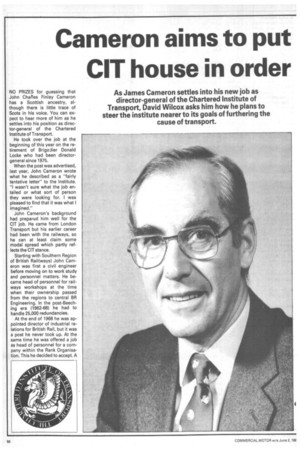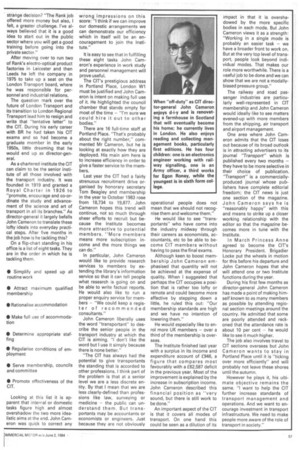Cameron aims to put CIT house in order
Page 58

Page 59

If you've noticed an error in this article please click here to report it so we can fix it.
As James Cameron settles into his new job as director-general of the Chartered Institute of Transport, David Wilcox asks him how he plans to steer the institute nearer to its goals of furthering the cause of transport.
NO PRIZES for guessing that John Chahes Finlay Cameron has a Scottish ancestry, although there is little trace of Scots in his voice. You can expect to hear more of him as he settles into his position as director-general of the Chartered Institute of Transport.
He took over the job at the beginning of this year on the retirement of Brigadier Donald Locke who had been directorgeneral since 1975.
When the post was advertised, last year, John Cameron wrote what he described as a "fairly tentative letter" to the Institute. "I wasn't sure what the job entailed or what sort of person they were looking for. I was pleased to find that it was what I imagined."
John Cameron's background had prepared him well for the CIT job. He came from London Transport but his earlier career had been with the railways, so he can at least claim some modal spread which partly reflects the CIT stance.
Starting with Southern Region of British Rail(ways) John Cameron was first a civil engineer before moving on to work study and personnel matters. He became head of personnel for railways workshops at the time when their ownership passed from the regions to central BR Engineering. In the post-Beeching era (1962-68) he had to handle 25,000 redundancies.
At the end of 1968 he was appointed director of industrial relations for British Rail, but it was a post he never took up. At the same time he was offered a job as head of personnel for a company within the Rank Organisation. This he decided to accept. A strange decision? "The Rank job offered more money but also, I felt, a greater challenge. I've always believed that it is a good idea to start out in the public sector where you will get a good training before going into the private sector."
After moving over to run two of Rank's electro-optical product factories in Leicester and then Leeds he left the company in 1975 to take up a seat on the London Transport board, where he was responsible for personnel and industrial relations.
The question mark over the future of London Transport and its transition to London Regional Transport lead him to resign and write that "tentative letter" to the CIT. During his early career with BR he had taken his CIT exams and so had become a graduate member in the early 1950s, little dreaming that he would end up as director-general.
As a chartered institute the CIT can claim to be the senior institute of all those involved with the transport industry. It was founded in 1919 and granted a Royal Charter in 1926 to "promote, encourage and co-ordinate the study and advancement of the science and art of transport in all its branches." As director-general it largely befalls John Cameron to translate these lofty ideals into everyday practical steps. After five months in the job how is he tackling this?
On a flip-chart standing in his office is a list of eight tasks. They are in the order in which he is tackling them.
• Simplify and speed up all routine work • Attract maximum qualified membership • Rationalise accommodation • Make full use of accommodation • Determine appropriate staffing • Regularise conditions of employment • Serve membership, councils and committee • Promote effectiveness of the CIT.
Looking at this list it is apparent that internal or domestic tasks figure high and almost overshadow the two more idealistic aims at the end. John Cameron was quick to correct any wrong impressions on this score: "I think if we can improve our domestic arrangements we can demonstrate our efficiency which in itself will be an encouragement to join the Institute."
It is easy to see that in fulfilling these eight tasks John Cameron's experience in work study and personnel management will prove useful.
The CIT's prestigious address in Portland Place, London W1 must be justified and John Cameron is intent on making full use of it. He highlighted the council chamber that stands empty for most of the time — "I'm sure we could hire it out to other bodies."
There are 16 full-time staff at Portland Place. "That's probably about the right number," commented Mr Cameron, but he is looking at exactly how they are deployed. His main aim here is to increase efficiency in order to give a faster service to the members.
Last year the CIT had a fairly strenuous recruitment drive organised by honorary secretary Tom Beagley and membership in the year to October 1983 rose from 18,734 to 19,877. John Cameron hopes this trend will continue, not so much through sheer efforts to recruit but because the Institute becomes more attractive to potential members. "More members means more subscription income and the more things we can do."
In particular, John Cameron would like to provide research services to members by extending the library's information service so that it can tell people what research is going on and be able to write factual reports. He would also like to run a proper enquiry service for members — "We could keep a register of recommended consultants."
John Cameron liberally uses the word "transportant" to describe the senior people in the transport industry at which the CIT is aiming. "I don't like the word but I use it simply because there is none better."
"The CIT has always had the potential to give transportants the standing that is accorded to other professions. I think part of the problem is that at a senior level we are a less discrete entity. By that I mean that we are less clearly-defined than professions like law, surveying or medicine — the public can understand them. But transportents may be accountants or economists or engineers. Just because they are not obviously operational people does not mean that we should not recognise them and welcome them."
He would like to see "transportents" who have come into the industry midway through their careers as economists, accountants, etc to be able to become CIT members without having to pass the final exams.
Although keen to boost membership John Cameron emphasised that quantity will not be achieved at the expense of quality. When I suggested that perhaps the CIT occupies a position that is rather too lofty or remote and could become more effective by stepping down a little, he ruled this out: "Our membership standards are high and we have no intention of lowering them."
He would especially like to enrol more UK members — over a third of the membership is overseas.
The Institute finished last year with a surplus in its income and expenditure account of £946, a figure that compares most favourably with a £62,587 deficit in the previous year. Most of the improvement is explained by the increase in subscription income. John Cameron described this financial position as "very sound, but there is still work to be done."
An important aspect of the CIT is that it covers all modes of transport. On one hand this could be seen as a dilution of its impact in that it is overshadowed by the more specific bodies in each mode. But John Cameron views it as a strength: "Working in a single mode is probably an easier task — we have a broader front to work on. But at the very top level of transport, people look beyond individual modes. That makes our role more worthwhile. There is a useful job to be done and we can show that we are not a modallybiased pressure group."
The railway and road passenger industries are particularly well-represented in CIT membership and John Cameron would ideally like to see matters evened-up with more members from the shipping, air transport and airport management.
One area where John Cameron admits that the CIT loses out because of its broad outlook is in attracting advertisers to its journal "Transport" which is published every two months — they have to be more selective in their choice of publication. "Transport" is a commerciallyproduced journal whose publishers have complete editorial freedom; the CIT news is just one section of the magazine. John Cameron says he is "reasonably happy" with this and means to strike up a closer working relationship with the editor so that the magazine becomes more in tune with the Institute.
In March Princess Anne agreed to become the CIT's Honorary President. Brigadier Locke put the wheels in motion for this before his departure and John Cameron hopes that she will attend one or two Institute functions during the year.
During his first few months as director-general John Cameron has made a point of making himself known to as many members as possible by attending regional section meetings around the country. He admitted that some are poorly attended and reckoned that the attendance rate is about 10 per cent — he would like to see it much higher.
The job also involves travel to CIT sections overseas but John Cameron wants to stay in Portland Place until it is "ticking over more efficiently" and will probably not leave these shores until the autumn.
However he plays it, his ultimate objective remains the same. "I want to help the CIT further increase standards of transport management and operations. And we want to encourage investment in transport infrastructure. We need to make people more aware of the role of transport in society."
























































































